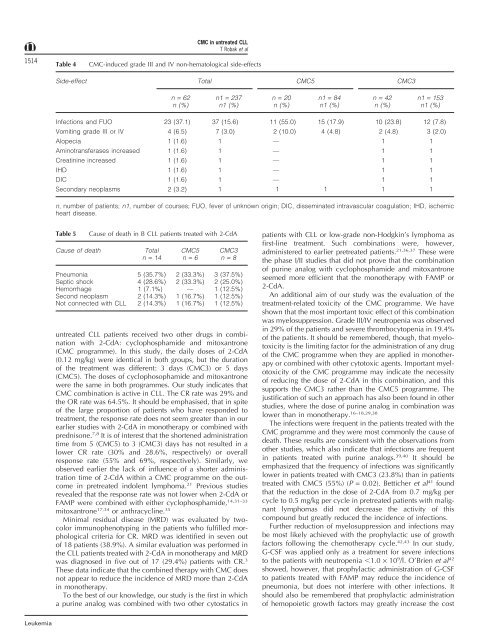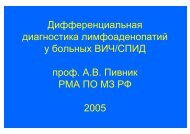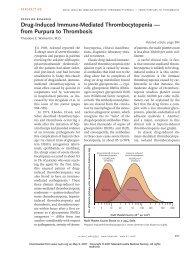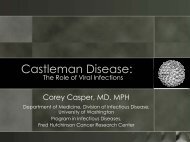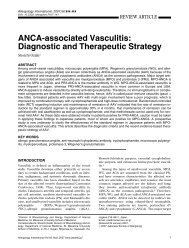Cladribine combined with cyclophosphamide and ... - Hem-aids.ru
Cladribine combined with cyclophosphamide and ... - Hem-aids.ru
Cladribine combined with cyclophosphamide and ... - Hem-aids.ru
Create successful ePaper yourself
Turn your PDF publications into a flip-book with our unique Google optimized e-Paper software.
1514<br />
Table 4<br />
CMC in untreated CLL<br />
T Robak et al<br />
CMC-induced grade III <strong>and</strong> IV non-hematological side-effects<br />
Side-effect Total CMC5 CMC3<br />
n = 62 n1 = 237 n = 20 n1 = 84 n = 42 n1 = 153<br />
n (%) n1 (%) n (%) n1 (%) n (%) n1 (%)<br />
Infections <strong>and</strong> FUO 23 (37.1) 37 (15.6) 11 (55.0) 15 (17.9) 10 (23.8) 12 (7.8)<br />
Vomiting grade III or IV 4 (6.5) 7 (3.0) 2 (10.0) 4 (4.8) 2 (4.8) 3 (2.0)<br />
Alopecia 1 (1.6) 1 — 1 1<br />
Aminotransferases increased 1 (1.6) 1 — 1 1<br />
Creatinine increased 1 (1.6) 1 — 1 1<br />
IHD 1 (1.6) 1 — 1 1<br />
DIC 1 (1.6) 1 — 1 1<br />
Secondary neoplasms 2 (3.2) 1 1 1 1 1<br />
n, number of patients; n1, number of courses; FUO, fever of unknown origin; DIC, disseminated intravascular coagulation; IHD, ischemic<br />
heart disease.<br />
Table 5<br />
Cause of death in B CLL patients treated <strong>with</strong> 2-CdA<br />
Cause of death Total CMC5 CMC3<br />
n = 14 n = 6 n = 8<br />
Pneumonia 5 (35.7%) 2 (33.3%) 3 (37.5%)<br />
Septic shock 4 (28.6%) 2 (33.3%) 2 (25.0%)<br />
<strong>Hem</strong>orrhage 1 (7.1%) — 1 (12.5%)<br />
Second neoplasm 2 (14.3%) 1 (16.7%) 1 (12.5%)<br />
Not connected <strong>with</strong> CLL 2 (14.3%) 1 (16.7%) 1 (12.5%)<br />
untreated CLL patients received two other d<strong>ru</strong>gs in combination<br />
<strong>with</strong> 2-CdA: <strong>cyclophosphamide</strong> <strong>and</strong> mitoxantrone<br />
(CMC programme). In this study, the daily doses of 2-CdA<br />
(0.12 mg/kg) were identical in both groups, but the duration<br />
of the treatment was different: 3 days (CMC3) or 5 days<br />
(CMC5). The doses of cyclophosophamide <strong>and</strong> mitoxantrone<br />
were the same in both programmes. Our study indicates that<br />
CMC combination is active in CLL. The CR rate was 29% <strong>and</strong><br />
the OR rate was 64.5%. It should be emphasised, that in spite<br />
of the large proportion of patients who have responded to<br />
treatment, the response rate does not seem greater than in our<br />
earlier studies <strong>with</strong> 2-CdA in monotherapy or <strong>combined</strong> <strong>with</strong><br />
prednisone. 7,8 It is of interest that the shortened administration<br />
time from 5 (CMC5) to 3 (CMC3) days has not resulted in a<br />
lower CR rate (30% <strong>and</strong> 28.6%, respectively) or overall<br />
response rate (55% <strong>and</strong> 69%, respectively). Similarly, we<br />
observed earlier the lack of influence of a shorter administration<br />
time of 2-CdA <strong>with</strong>in a CMC programme on the outcome<br />
in pretreated indolent lymphoma. 21 Previous studies<br />
revealed that the response rate was not lower when 2-CdA or<br />
FAMP were <strong>combined</strong> <strong>with</strong> either <strong>cyclophosphamide</strong>, 14,31–33<br />
mitoxantrone 17,34 or anthracycline. 35<br />
Minimal residual disease (MRD) was evaluated by twocolor<br />
immunophenotypingin the patients who fulfilled morphological<br />
criteria for CR. MRD was identified in seven out<br />
of 18 patients (38.9%). A similar evaluation was performed in<br />
the CLL patients treated <strong>with</strong> 2-CdA in monotherapy <strong>and</strong> MRD<br />
was diagnosed in five out of 17 (29.4%) patients <strong>with</strong> CR. 3<br />
These data indicate that the <strong>combined</strong> therapy <strong>with</strong> CMC does<br />
not appear to reduce the incidence of MRD more than 2-CdA<br />
in monotherapy.<br />
To the best of our knowledge, our study is the first in which<br />
a purine analogwas <strong>combined</strong> <strong>with</strong> two other cytostatics in<br />
patients <strong>with</strong> CLL or low-grade non-Hodgkin’s lymphoma as<br />
first-line treatment. Such combinations were, however,<br />
administered to earlier pretreated patients. 21,36,37 These were<br />
the phase I/II studies that did not prove that the combination<br />
of purine analog<strong>with</strong> <strong>cyclophosphamide</strong> <strong>and</strong> mitoxantrone<br />
seemed more efficient that the monotherapy <strong>with</strong> FAMP or<br />
2-CdA.<br />
An additional aim of our study was the evaluation of the<br />
treatment-related toxicity of the CMC programme. We have<br />
shown that the most important toxic effect of this combination<br />
was myelosuppression. Grade III/IV neutropenia was observed<br />
in 29% of the patients <strong>and</strong> severe thrombocytopenia in 19.4%<br />
of the patients. It should be remembered, though, that myelotoxicity<br />
is the limitingfactor for the administration of any d<strong>ru</strong>g<br />
of the CMC programme when they are applied in monotherapy<br />
or <strong>combined</strong> <strong>with</strong> other cytotoxic agents. Important myelotoxicity<br />
of the CMC programme may indicate the necessity<br />
of reducingthe dose of 2-CdA in this combination, <strong>and</strong> this<br />
supports the CMC3 rather than the CMC5 programme. The<br />
justification of such an approach has also been found in other<br />
studies, where the dose of purine analogin combination was<br />
lower than in monotherapy. 16–18,29,38<br />
The infections were frequent in the patients treated <strong>with</strong> the<br />
CMC programme <strong>and</strong> they were most commonly the cause of<br />
death. These results are consistent <strong>with</strong> the observations from<br />
other studies, which also indicate that infections are frequent<br />
in patients treated <strong>with</strong> purine analogs. 39,40 It should be<br />
emphasized that the frequency of infections was significantly<br />
lower in patients treated <strong>with</strong> CMC3 (23.8%) than in patients<br />
treated <strong>with</strong> CMC5 (55%) (P = 0.02). Betticher et al 41 found<br />
that the reduction in the dose of 2-CdA from 0.7 mg/kg per<br />
cycle to 0.5 mg/kg per cycle in pretreated patients <strong>with</strong> malignant<br />
lymphomas did not decrease the activity of this<br />
compound but greatly reduced the incidence of infections.<br />
Further reduction of myelosuppression <strong>and</strong> infections may<br />
be most likely achieved <strong>with</strong> the prophylactic use of growth<br />
factors followingthe chemotherapy cycle. 42,43 In our study,<br />
G-CSF was applied only as a treatment for severe infections<br />
to the patients <strong>with</strong> neutropenia 1.0 × 10 9 /l. O’Brien et al 42<br />
showed, however, that prophylactic administration of G-CSF<br />
to patients treated <strong>with</strong> FAMP may reduce the incidence of<br />
pneumonia, but does not interfere <strong>with</strong> other infections. It<br />
should also be remembered that prophylactic administration<br />
of hemopoietic growth factors may greatly increase the cost<br />
Leukemia


